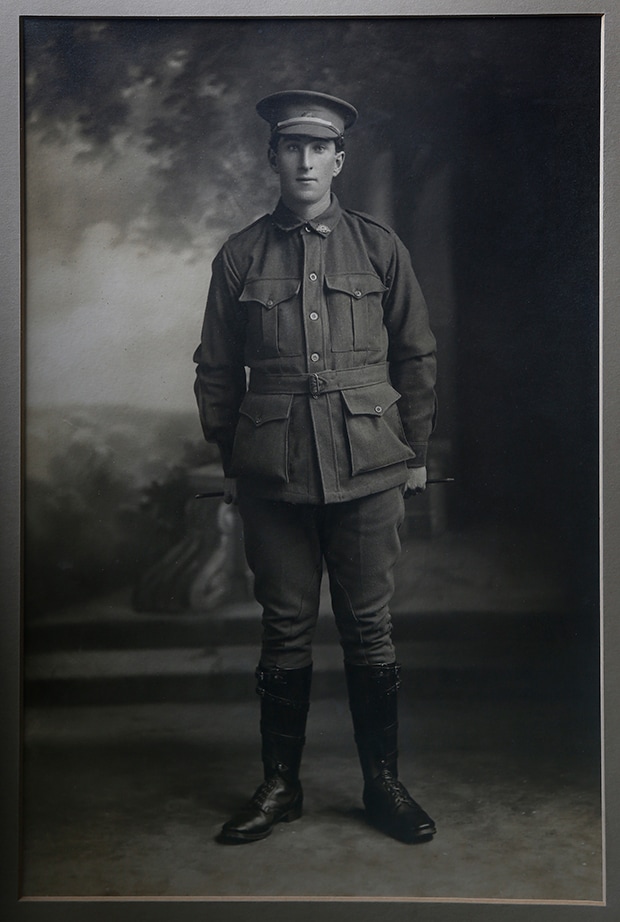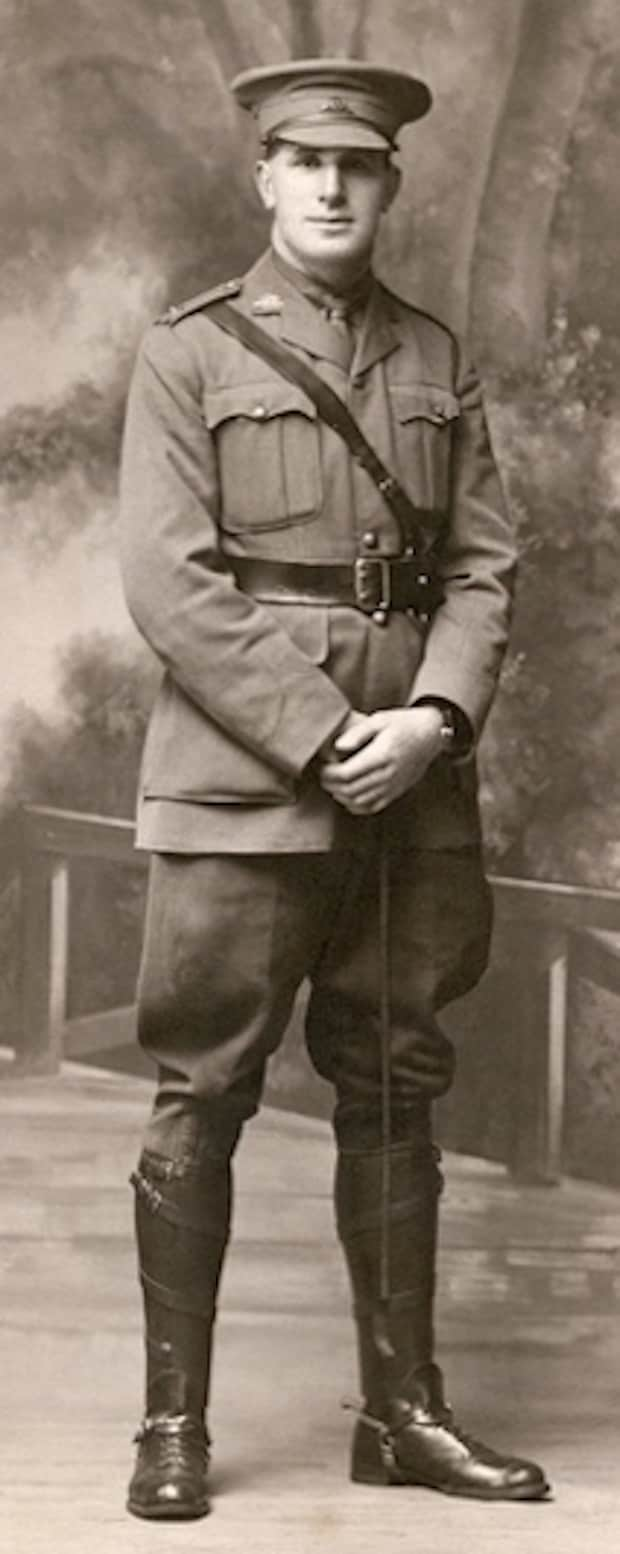Last December, a film crew arrived in the Hawks Museum to capture images of the oldest surviving guernsey connected to a Hawthorn player. It is not a Hawthorn guernsey. It is navy blue and emblazoned on the front is a white felt map of mainland Australia. The guernsey is from the AIF 3rd Division team that played in the famous 1916 Pioneer Exhibition Game against a Combined Training Units side at Queen’s Club, Kensington to raise funds for the British and French Red Cross.
Made up of VFL and VFA players serving in the Australian Imperial Forces, the team and the Division were in England training to fight in the trenches of the Western Front. Three Hawthorn players were in that 3rd Division side, including the original wearer of the guernsey, Dan Minogue, the team’s vice-captain.
Football was an important diversion for Australian troops, many units had their own teams, competing fiercely for bragging rights on any type of ground, even near the front lines. But, the Pioneer Exhibition game was the first organised game to be played overseas by elite footballers.
The film crew’s images of the Minogue guernsey will help tell the story of Australian involvement on the Western Front 1916-1918, part of a multimedia exhibition at the new Sir John Monash Centre. Before he was appointed Commander in Chief of the Australian Corps in 1918, Monash had been the commander of the Australian 3rd Division. This museum opens in Villers Bretonneux on Anzac Day, the 100th anniversary of the retaking of the French town by Australian troops. The three Hawthorn players who were in that Exhibition game all served on the Western Front.

Dan Minogue in uniform, 1916.
Bombardier Daniel Thomas Minogue enlisted in March 1916 when he was 24 years old. He listed his occupation as telephone mechanic, but he was better known as the captain of Collingwood, where he played 85 games, 1911-1916. Minogue became a gunner in Sections 2 and 3 of the 3rd Division Ammunition Column, the unit that kept frontline infantry and artillery supplied with shells, cartridges, Mills bombs and the like. They also maintained ammunition dumps. It was a dangerous undertaking, and they were often under enemy fire.
Embarking for England in June of 1916, Minogue trained at Lark Hill Camp on Salisbury Plain. In November the Division proceeded to France just in time for a shockingly bitter winter. Minogue was promoted to Bombardier in January 1917. He was also appointed Acting Corporal on several occasions.
Apart from several visits to hospital through illness and injuries to his wrist and knee, Minogue saw service in Belgium and France until the end of the war. Returning to Australia in May 1919, his service. was recognised in a letter of commendation from Major General John Gellibrand, then commander of the 3rd Division. It congratulated Temporary Corporal Minogue for the ‘conspicuous manner in which he had conducted himself on the battlefield in the face of the enemy.’
Minogue resumed his football, first with Richmond, 1920-1925. He was captain – coach of Richmond’s 1920 and 1921 premiership sides. In 1926, he was appointed Captain-Coach of Hawthorn. He played just one game before a knee injury ended his playing career. Minogue continued to coach the club for the next two seasons. A member of the VFL/AFL Hall of Fame, Dan Minogue died in 1961. Thanks to his grandson, also named Dan, and a great Hawk supporter, the 3rd Division guernsey is on display in the Hawks Museum.
Private Edwin John ‘Ted’ Alley was known as a centreman with dash. He played for South Melbourne in 1902-3 and captained Williamstown during their 1907 VFA premiership in the absence of their regular captain. An engineer by trade, he enlisted in February 1916, joining Company A of the 3rd Pioneer Battalion. Pioneers were field engineers who could also fight as infantry. The unit’s War Diary entries underline just how busy - and necessary - these troops were. They constructed roads, trench systems, workshops, bridges, dugouts, bomb proofs, gun emplacements etc. Ted Alley’s battalion, though, spent more days as infantry on the front line than any other pioneer unit.
Alley’s battalion embarked from Melbourne on the 6th of June 1916 for training in England. Whilst in England, Alley captained the 3rd Pioneer football team and was named best afield in a game against an Australian Field Ambulance side that included several League players.
The 3rd Pioneers arrived in France on November 25, 1916 and spent a vicious winter in Armentieres. Alley survived actions in Flanders at Messines - the 3rd Division’s baptism of fire on the Western Front - and Broodseindes in 1917. In March - April 1918, whilst they were attached to the 10th Infantry Brigade, the 3rd Pioneers helped blunt the German Spring offensive at Dernancourt, Ribemont and Heilly, north of the Somme River.
On May 9th, 1918, the day before his company was sent south to relieve elements of the 4th Pioneers at Villers Bretonneux, Ted Alley fractured a knee cap. He was sent to various hospitals in France and England before being invalided back to Australia in November 1918. Private Alley was discharged in February 1919.

Studio portrait of Lieutenant Jack Brake.
Alley recovered from his knee injury well enough to continue a playing career. He joined the Hawthorn Football Club in 1919, playing 17 games over two seasons. He was appointed Captain for the 1920 season but relinquished the captaincy after only four games. Edwin Alley died in 1949.
Lieutenant John ‘Jack’ Brake was a star athlete. He held several records in the pole vault and other field events during his school days at Hawthorn College. He became Australasian pole vault champion in 1911 and 1914. A talented ruckman, Brake joined the Hawthorn Football Club, playing the first four games of the 1909 season. Noted in newspaper reports for his ‘sterling play’ for Hawthorn, he was in his first year of an Agricultural Science degree at Melbourne University.
He was recruited to the University’s VFL side in July 1909, becoming one of their few genuine stars. Sport magazine exclaimed, ‘What a player Jack Brake is … he has no superior on the field!’ He played 81 games between 1909 and 1914 and represented Victoria on eight occasions. The University side folded at the end of the 1914 season. Brake transferred to the Melbourne Football Club where he played 11 games in the 1915 season. He completed his degree in 1915 and enlisted in the AIF in December of that year.
He embarked for England aboard the HMAT Medic with the 8th Australian Field Artillery Brigade, 3rd Division Artillery, in May 1916. He trained with the 23rd Battery in England before heading to France on December 31st, 1916. Brake transferred to the 30th Battery as wagon line officer. He was promoted to full Lieutenant in January 1917 and was transferred to Brigade HQ in July of that year. He was also borrowed on occasion by 3rd Division HQ as Adjutant.
In a letter to a friend, Brake mentions that although casualties were high in his unit, he was, ‘still jogging along keeping my head as low as possible … I could do with a good game of football now.’ As ordinance officer he remained in the field and, ’in some tight corners,’ in Flanders and on the Somme. By mid-1918 his Brigade was helping to hold the line at Villers Bretonneux.
On April 21, 1918, at Vaux-sur-Somme, Brake wrote in his diary that he watched as a German plane was hit, ‘circled around and crashed out of view.’ It was the famous red Fokker tri-plane of Manfred von Richtofen – the Red Baron.
Following the Armistice of November 1918, Brake was sent to Paris overseeing British troops. In January 1919 his commanding officer recommended him for the Military Cross for ‘his excellent service … and devotion to duty’ during the war. Whist he never received this award, Brake was considered ‘an excellent example to all ranks.’
In 1919 Brake represented the AIF in the Allied Services Games in Paris, competing in the pole vault. He was attached to the ‘Sports Section’ at AIF HQ, London, keeping those Australian troops still overseas well occupied with football, cricket, athletics and the like. He returned to Australia for discharge in November 1919 and joined the Victorian Department of Agriculture. He played a further six games for Melbourne in the 1920 and 1921 seasons.
Jack Brake also served during World War 2, holding the rank of Major in the 2nd Medium Artillery Regiment. He transferred to command a section of the Melbourne University Rifles Militia Battalion.
In later years he became the Victorian Superintendent of Agriculture. He also served as a member of the VFL tribunal. John Brake died in 1970.
These players from the 3rd Division side are but a few of the Hawthorn footballers who served in the AIF during the First World War. You may not be able to travel to France or Belgium, but you can still see a precious piece of Australian war service history at Waverley Park as Dan Minogue’s original 3rd Division guernsey is on display in the Hawks Museum.



